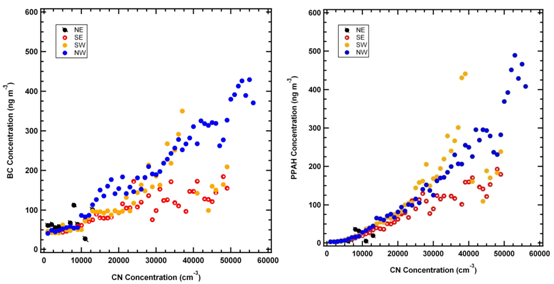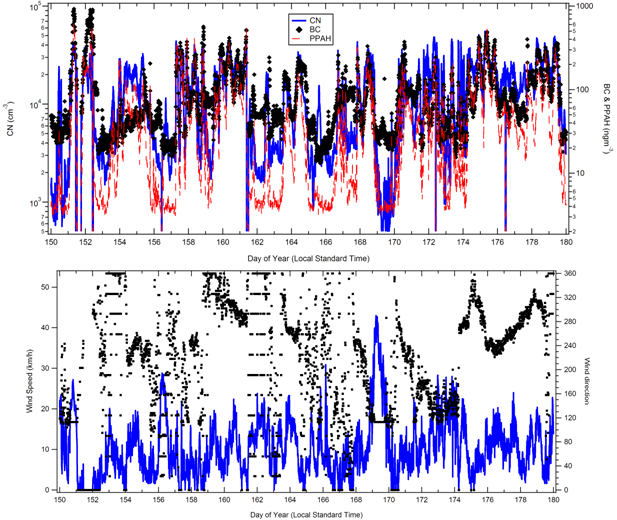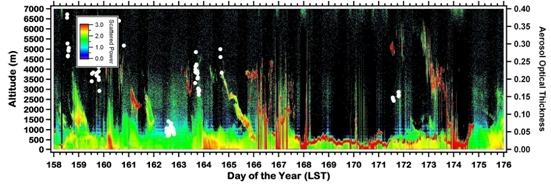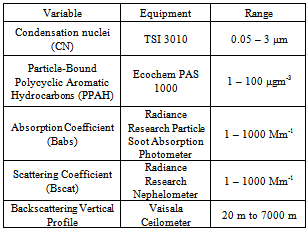-
Paper Information
- Next Paper
- Previous Paper
- Paper Submission
-
Journal Information
- About This Journal
- Editorial Board
- Current Issue
- Archive
- Author Guidelines
- Contact Us
American Journal of Environmental Engineering
p-ISSN: 2166-4633 e-ISSN: 2166-465X
2013; 3(1): 71-76
doi:10.5923/j.ajee.20130301.10
Study of Some Aerosol Features in Buenos Aires
Ana Graciela Ulke 1, 2, Graciela Raga 3, Darrel Baumgardner 3
1Departamento de Ciencias de la Atmósfera y los Océanos, Facultad de Ciencias Exactas y Naturales, Universidad de Buenos Aires, Buenos Aires, C1428EGA, Argentina
2Unidad Mixta Internacional, Instituto Franco Argentino sobre Estudios de Clima y sus Impactos (IFAECI)/CNRS
3Centro de Ciencias de la Atmósfera, Universidad Nacional Autónoma de México, México DF, 04510, México
Correspondence to: Ana Graciela Ulke , Departamento de Ciencias de la Atmósfera y los Océanos, Facultad de Ciencias Exactas y Naturales, Universidad de Buenos Aires, Buenos Aires, C1428EGA, Argentina.
| Email: |  |
Copyright © 2012 Scientific & Academic Publishing. All Rights Reserved.
We present the analysis of in-situ measurements obtained in an experimental campaign in Buenos Aires. Observations of total condensation nuclei (CN), black carbon (BC), polycyclic aromatic hydrocarbon concentration in particulate phase (PPAH), vertical profiles of aerosol light backscattering and meteorological parameters, were obtained at a coastal site during a one-year period. The study provides detailed and novel information about the contributions to the aerosol load in the atmosphere of Buenos Aires due to the combined action of a variety of sources and dispersion mechanisms. Furthermore, they provide a unique dataset to evaluate modeling tools.
Keywords: Urban Air Pollution, Black Carbon, Polycyclic Aromatic Hydrocarbon
Cite this paper: Ana Graciela Ulke , Graciela Raga , Darrel Baumgardner , Study of Some Aerosol Features in Buenos Aires, American Journal of Environmental Engineering, Vol. 3 No. 1, 2013, pp. 71-76. doi: 10.5923/j.ajee.20130301.10.
Article Outline
1. Introduction
- Buenos Aires (34º38’S, 58º28’W) is a megacity situated on the right coast of the Rio de la Plata. With a surface of nearly 3800 km2, it has a population of 11 million inhabitants and ranks as the third in Latin America. The air pollution in the city is due both to the local sources and regional or remote contributions. In particular, the aerosol load in the urban atmosphere might be an issue of concern not only in the short term as regards public health or visibility, but also by the possible impacts on climate and the hydrological cycle. Among the studies that reported measurements of particles, Arkouli et al. (2010) performed a one year campaign and the obtained PM10 and PM2.5 values were higher from July to September. The PM10 daily values were greater than the European Union limit on 36 occasions. The World Health Organization (WHO) guideline value for daily PM2.5 was exceeded 21 times. As regards the annual averages, the PM10 mean was almost 70% of the Buenos Aires limit and the PM2.5 annual mean was similar to the limit. The annual averages were above the WHO air quality guidelines. Another study reported twenty-four hour averages of PM10 and PM2.5 measured (not simultaneously) at a site near downtown Buenos Aires. The values of PM2.5 concentrations correlated well with the concentrations of carbon monoxide during winter, indicating that direct traffic emissions have an important contribution to PM2.5. The data were less correlated for PM10, indicating that coarse fraction has an important contribution of other sources, for example re-suspended material[2].These works represent the impact of the local sources, mainly the traffic as well as the thermo electrical plants and industries. In addition, the regional pollution is related to biomass burning, sea salt and dust. On the side of natural aerosols like sea salt, Dos Santos et al. (2012) found robust evidence that the marine aerosol from the South Atlantic Ocean reaches the city of Buenos Aires. Eventually, the western region of South America has also an important number of active volcanoes that can erupt and release to the atmosphere a variety of pollutants, which can travel far away transported by the free atmosphere winds.The contribution of biomass burning is more noticeable from August to October. These months correspond to the main burning activities in central South America (northern Argentina, Paraguay, Bolivia and central Brazil)[4,5,6]. However, as the practice is common in the agricultural sector, there are also contributions from nearby locations in Argentina[7,8] The latter are most frequent during the austral autumn.
 | Figure 1. Map of Buenos Aires city and location of the measurement site |
2. Data and Methodology
- Table 1 details the equipment that provided the data reported in this paper. The suite was fully operative from April to December 2011.The measurements from the condensation nuclei counter, nephelometer and particle soot absorption photometer were recorded every second. The mass concentration of particle bound polycyclic aromatic hydrocarbons was recorded every 5 s. The weather meteorological station measured the state parameters and wind and the recording rate was every minute. Black carbon (BC) mass concentration was derived from the absorption coefficient, Babs, using the factory recommended specific absorption coefficient of 10 m μg−1. This conversion factor was applied after the absorption coefficients had been corrected to account for differences from factory specifications in deposit area and flow rate and for the effects of light scattering. The reported concentrations from the PPAH analyzer are discussed with respect to relative changes because they were not compared with an analytical method, as recommended by the manufacturer.
|
3. Results and Discussion
- Figure 2 depicts the monthly values obtained from a basic statistical analysis of the derived concentrations. The CN mean values ranged from 4880 cm-3 to 13500 cm-3 and the median from 3400 cm-3 to 11000 cm-3. Maximum values varied from 24000 to 64000 cm-3. BC median values were between 0.04 μgm-3 and 0.07 μgm-3, the mean values ranged from 0.06 to 0.1 μgm-3 and the maxima from 0.8 to 2 μgm-3. PPAH mean resulted between 0.02 and 0.06 μgm-3, the median values varied from 0.06 to 0.3 μgm-3, and the maxima between 0.3 and 0.6 μgm-3. The obtained monthly values are within the order of magnitude than similar locations worldwide[9]. In general, the measurements show the higher values during winter suggesting that the health risk due to exposure in winter is higher than in summer. During the cold period, the concentrations exhibited a high variability. The seasonal behaviour is similar to the variations in aerosol properties observed elsewhere[9]. These variations are likely due to a combination of changes in emissions rates and meteorology. In winter the increase in anthropogenic emissions associated with domestic heating combine with unfavourable dilution ability mainly due to shallow atmospheric boundary layer[10]. The variability is mainly related to the mid-latitude transient systems that reach the city more frequently during the cold season. Another source of variability was the arrival of the ash plume from the Puyehue-Cordon Caulle in Chile that erupted on 4 June and reached the city several times till October. Figure 3 shows the relationships between the concentrations of BC, PPAH and CN for different wind sectors: NE (from the de La Plata River), SE (from the power plants and industries), SW (from the city and suburbs) and NW (from the northern region of the city). In the NW sector the variables are well correlated and have the largest concentrations, in the SE sector relatively lower BC and PPAH concentrations are registered; the SW sector has a bifurcation for high CN values and the NE sector corresponds to clean air masses. High concentrations of CN, PPAH, BC are associated with winds from W and NW, which points to urban common sources. Intermediate BC concentrations, low CN concentrations and very low PPAH concentrations are present with variable wind directions. Strong easterly winds that bring clean air from the La Plata River are related to intermediate BC, very low CN and PPAH concentrations.
 | Figure 3. BC and PPAH concentrations (ngm-3) versus CN concentrations (cm-3) by wind sector |
 | Figure 4. Time series of CN, BC and PPAH concentrations (upper panel) and wind (bottom panel) |
 | Figure 5. Evolution and vertical distribution of aerosols (shaded) and aerosol optical thickness (dots) |
4. Conclusions
- The condensation nuclei (CN) reached 60000 cm-3, black carbon (BC) peaked at 800 ngm-3 and polycyclic aromatic hydrocarbon (PPAH) concentration in particulate phase exceeded 500 ngm-3. These values are as large as those often found in other urban areas with populations much larger than in Buenos Aires. The different relationships between pollutants according to the wind sector clearly show the influence of sources. To the knowledge of the authors this is the first observational campaign that reports the concentrations of CN, BC and PPAH in Buenos Aires, for nearly a year period. The adverse effects of BC and PPAH demand this type of characterization to contribute to manage local, regional as well as global air pollution control strategies.
ACKNOWLEDGEMENTS
- The authors acknowledge funding from the University of Buenos Aires UBACyT-X224 and 20020100101013, the Agencia Nacional de Promoción Científica and Tecnológica through project PICT2008-1739ANPCyT-2008-1739 and SEMARNAT-CONACYT-23498 projects. Brent Holben for providing the AERONET data.
 Abstract
Abstract Reference
Reference Full-Text PDF
Full-Text PDF Full-text HTML
Full-text HTML
